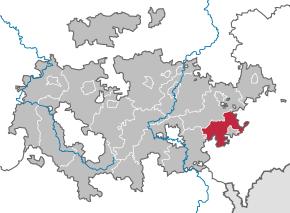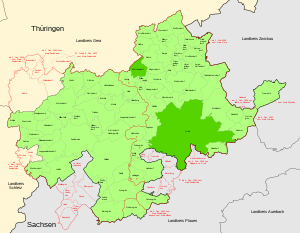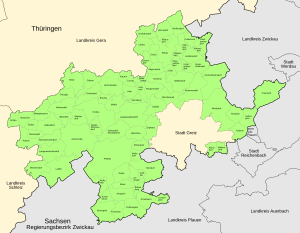District of Greiz (1922–1952)
| Basic data | |
|---|---|
| Inventory period | 1855–1919 (District Office) 1919–1922 (District Association) 1922–1952 (District) |
| Administrative headquarters | Greiz |
| Residents | 52,399 (VZ 1939) |
| Communities | 84 (1939) |
| surface | 370.97 km² (1941) |

|
|
| Location of the district of Greiz in Thuringia in 1922 |
|
The district of Greiz was a district in Thuringia from 1922 to 1952 . The district seat was in Greiz . The former district area today largely belongs to the current district of Greiz in Thuringia . From 1855 to 1919 the Landratsamt Greiz already existed in the Principality of Reuss older line and from 1919 to 1922 in the People's State of Reuss and in Thuringia the Greiz District Association .
history
Reuss older line

As part of the separation of administration and justice, a district office was set up for the entire Principality of Reuss older line on October 1, 1868. In the Burgk exclave , the local judicial office took over some of the powers of the district administration.
People's State of Reuss
On April 17, 1919, Reuss older line and Reuss younger line merged to form the People's State of Reuss. The Greiz District Office became the Greiz District Association , albeit with a different definition. The communities of Göttendorf , Hohenleuben , Langenwetzendorf , Neuärgerniß , Niederböhmersdorf , Pöllwitz , Triebes and Weißendorf from the old district office of Gera changed to the Greiz district association. The municipalities of Kleinwolschendorf , Langenwolschendorf , Leitlitz , Pahren and Weckersdorf also moved from the old Schleiz district office to the Greiz district association. In return, the district court district of Burgk with the municipalities of Burgk , Crispendorf , Dörflas , Friesau , Grochwitz , Mönchgrün , Möschlitz , Neundorf , Pahnstangen , Plothen , Rauschengesees , Remptendorf , Röppisch and Zoppoten joined the Schleiz district association from the old Greiz district office.
State of Thuringia
After the new state of Thuringia was founded in 1920, a comprehensive regional reform took place in 1922. The communities of Hohenölsen and Neudörfel moved from the Greiz district association to the new Gera district ; in addition, the city of Greiz became a district. The rest of the Greiz district association formed the core of the new Greiz district, which also includes the city of Berga / Elster and the communities of Albersdorf , Clodra , Culmitzsch , Dittersdorf , Dörtendorf , Eula , Friedmannsdorf , Göhren , Großdraxdorf , Großkundorf , Katzendorf , Kleinkundorf , Krölpa , Markersdorf b. Berga , Merkendorf , Muntscha , Obergeißendorf , Piesigitz , Silberfeld , Staitz , Stelzendorf , Teichwolframsdorf , Untergeißendorf , Waltersdorf , Wenigenauma , Wernsdorf , Wolfersdorf , Zadelsdorf , Zickra b. Auma and Zickra b. Berga came from the disbanded administrative district Neustadt an der Orla , which until 1920 belonged to Sachsen-Weimar-Eisenach .
On April 1, 1928, an exchange of territory with Saxony was carried out. The district of Greiz handed over the municipality of Görschnitz to the Saxon administration of Plauen .
GDR

Light green: Greiz district before July 1, 1950
Dark green: from July 1, 1950 to the Greiz district
Status municipality boundaries, state borders and black district boundaries: July 1, 1950
Status red District boundaries: January 1, 1956
During the first district reform in the GDR on July 1, 1950, the city of Greiz lost its district freedom and was incorporated into the district. In addition, the Wittchendorf community moved from the Gera district to the Greiz district.
During the administrative reform of 1952 in the GDR, the state of Thuringia was dissolved and the district of Greiz was divided:
- The communities Fraureuth and Gottesgrün came to the Werdau district in the Karl-Marx-Stadt district .
- The western part of the district with the towns of Hohenleuben , Triebes and Zeulenroda , together with communities in the districts of Gera , Plauen and Schleiz, formed the Zeulenroda district in the Gera district .
- The eastern part of the district with the cities of Greiz and Berga / Elster formed the district of Greiz in the Gera district.
Population development
| court House | district | |||||
|---|---|---|---|---|---|---|
| year | 1900 | 1910 | 1925 | 1933 | 1939 | 1946 |
| Residents | 68,396 | 72,769 | 50,802 | 52,405 | 52,399 | 64,760 |
Population of communities with more than 2,000 inhabitants (as of 1939):
| Berga | 2.002 |
| Fraureuth | 3,672 |
| Hohenleuben | 2,025 |
| Langenwetzendorf | 2.131 |
| Mohlsdorf | 2,104 |
| Instinct | 4,816 |
| Zeulenroda | 12,481 |
District administrators
- Eduard Knoll (1868–1882)
- Otto Heinrich Greve (1945)
cities and communes
In 1939 the district of Greiz comprised four cities and 80 other municipalities:
In the 1920s, the municipalities of Altgommla , Caselwitz , Dölau , Irchwitz , Kurtschau , Moschwitz , Neugommla , Obergrochlitz , Pohlitz , Raasdorf , Rothenthal , Sachswitz , Schönfeld and Untergrochlitz were incorporated into the city of Greiz and the municipality of Herrmannsgrün after Mohlsdorf.
Individual evidence
- ^ A b c d Michael Rademacher: German administrative history from the unification of the empire in 1871 to the reunification in 1990. greiz.html. (Online material for the dissertation, Osnabrück 2006).
- ^ Law on the organization of the judicial and administrative authorities on September 1, 1868 . In: Collection of laws of the Principality of Reuss older line . tape 1868 , no. 20 . Greiz 1868, p. 277 ff . ( Digitized version ).
- ↑ Government ordinance on the law on the organization of judicial and administrative authorities . In: Collection of laws of the Principality of Reuss older line . tape 1868 , no. 51 . Greiz 1868, p. 524 ( digitized version ).
- ^ Law on the unification of the two Free States of Reuss of April 4, 1919 . In: Collection of laws for both Free States of Reuss . tape 1919 , no. 5 . Greiz 1919, p. 27 ff . ( Digitized version ).
- ↑ State Treaty of December 7, 1927
- ↑ 1. Ordinance on the implementation of the law amending the district and municipal boundaries in the state of Thuringia of April 26, 1950
- ^ Supplement to the 1st regulation
- ↑ Law on the further democratization of the structure and functioning of state organs in the state of Thuringia of July 25, 1952
- ^ Uli Schubert: German community register 1910. Accessed on May 22, 2009 .
- ↑ 1946 census
